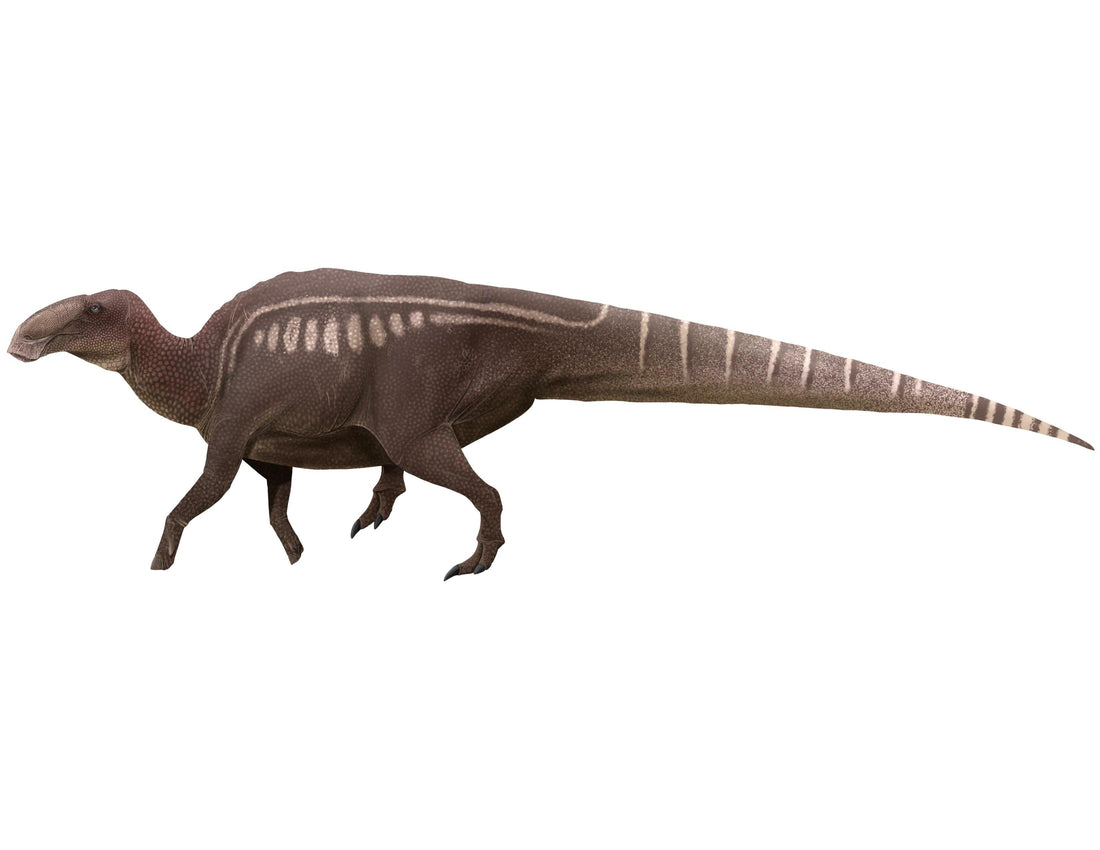
Edmontosaurus: Duck Bill Supreme
Share
Edmontosaurus annectens is one of the largest duck-billed dinosaurs to ever live, reaching 50’ in length and weighing 10 tons, the size of a small sauropod! These giants were among the last of the dinosaurs, living alongside Triceratops, Pachycephalosaurus, and Tyrannosaurus.
Edmontosaurus has gone by at least 8 different genus names, largely because so many amazing fossils of it have been discovered over the last 130 years, resulting in paleontologists using rarely discovered characters to justify naming a new dinosaur. With over 20 mostly complete skeletons discovered, many with skin impressions ( “mummies”), it is one of the best-known dinosaurs. Today only two species are considered valid, Edmontosaurus annectens and Edmontosaurus regalis. The two did not live at the same time but did live in the same place with E. annectens likely evolving from E. regalis (the older species).
“Mummies” are extremely well-preserved dinosaurs, so well preserved in fact that skin impressions are left, as well as ultra-rare sclerotic rings (bones that help hold the eye in place) stapes (ear bones), and stomach contents. Though it isn’t known how the “mummification” process happened, one hypothesis is the kind of bacteria present when the animal died caused biomineralization. They formed minerals around the decaying dinosaur’s skin. This kept the bones in place and, when buried by sediment, created a perfect cast of the skin.
Edmontosaurus is called a duck-billed dinosaur because the front of its mouth was wide and lacked teeth. It did have teeth, however, roughly 1,000 of them in fact! The teeth form columns, with up to 6 teeth making up a column. Each column is squished next to the next tooth column in such a way that there are no gaps in the teeth. This configuration is called a “dental battery” and is seen in ceratopsians and hadrosaurs. The teeth were constantly replaced, which was a good thing because they ate cycads, conifers, and Gingkos, all of which are very tough, fibrous plants. We know this because conifer needles and twigs have been found in the stomach of “mummies.” The wide mouth had a fleshy beak that scooped up plant matter and the hundreds of teeth then ground the tough food down. Reptiles don’t chew like mammals, however, in duck-bills the lower jaw moved back and forth, grinding the food down between the walls of teeth.
Edmontosaurus relied on speed to survive attacks from predators. Studies have suggested they could run up to 28 mph. Most of the time they walked on 4 legs, however they were capable of walking, and running, on two legs. Initially believed to live in the water, recent studies show these animals would have been poor swimmers. Their forelimbs are small and would not have worked as paddles. The tail, though huge and deep, was mostly inflexible. The species name annectens means connected because the tail had so many ossified tendons that kept the tail straight, keeping it from moving side-to-side to help it swim.
Edmontosaurus was definitely preyed upon by Tyrannosaurus and its cousins. Numerous specimens have been found with Tyrannosaurus bite marks on the bones. One animal had a Tyrannosaurus sized-and-shaped bite taken out of its tail, shearing off the tops of 4 tail bones! It was able to escape as the bones show signs of healing. Tyrannosaurus wasn’t the only predator, one of the Fossil Crates team, Mike, discovered an Edmontosaurus with healed bite marks on its lower jaws. He believes small theropods attacked its throat but the animal escaped, dying sometime later from an infection from the attack.
Edmontosaurus lived in herds, likely for safety. Three bonebeds are known where thousands of Edmontosaurus died at the same time. One bone bed is estimated to have over 10,000 individuals in it! Most likely these animals died in an enormous flood, possibly a gigantic flash flood. The mass casualties do confirm these animals lived in massive herds.
Watch more about Edmontosaurus here.
Purchase an Edmontosaurus tooth as part of the Ultimate Herbivores crate here.